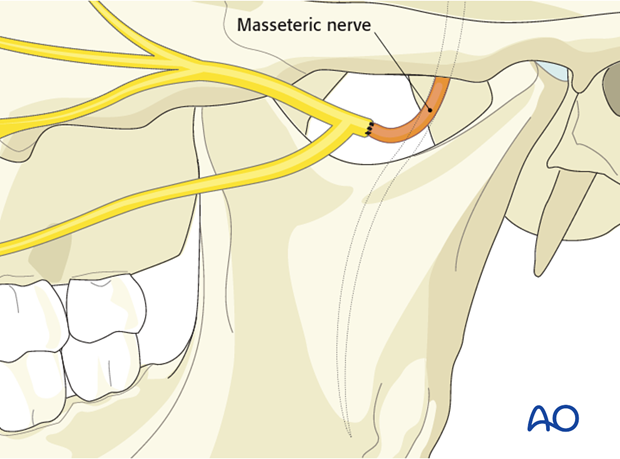Selective reinnervation with contralateral facial nerve and masseteric nerve
1. Introduction
The principle of selective reinnervation is to use a cross face reinnervation to power eye closure and the ipsilateral masseteric nerve to power the smile.
Smiling and biting are synchronous actions. Patients can learn to perform both activities naturally at the same time. This is a distinct advantage over other nerve input options, such as hypoglossal or spinal accessory.
With ongoing practice and physiotherapy, some patients can learn to smile spontaneously. This may occur due to cortical adaptation.
General considerations regarding nerve repair techniques can be found here.

2. Cross face reinnervation to power eye closure
Approach and branches identification
A facelift or parotidectomy type incision is performed on both the ipsilateral and the contralateral side, and the distal branches identified as they exit the parotid gland. Existing lacerations may also be used if present.

Preparation of contralateral nerves
On the contralateral side, intraoperative stimulation of the branches is used to identify which branches are responsible for eye-closure.
In general, multiple branches are identified and 50% of branches responsible for eye closure (orbicularis oculi) can be sacrificed without loss of function and used to power the paralyzed side through nerve graft.

Preparation of distal ipsilateral nerves
On the ipsilateral (paralyzed) side the distal branches of the facial nerve are exposed as they exit the parotid.
Intraoperative direct nerve stimulation may be possible up to 7 days from time of injury.
If not successful, the distal nerves are identified as they exit the parotid.
The distal nerves are dissected in retrograde fashion (from distal to proximal) through the parotid gland until the lacerated branches are identified.

Nerve harvest
In order to get adequate length of graft to reach the opposite side of the face one would require harvesting the sural nerve.
The nerve is harvested.

Nerve graft insertion
The nerve graft is inserted through a subcutaneous tunnel.
For eye closure the tunnel crosses over the nasal bridge or above the eye brows.
The tunnel can be created either using tendon instruments, long blunt curved hemostatic forceps, or dissecting scissors.

Nerve graft coaptation
Coaptation of nerve graft is performed to both the ipsilateral and contralateral facial nerves.

3. Masseteric nerve reinnervation
Masseteric nerve identification
The masseteric nerve is identified within the body of the masseter muscle at the level of the sigmoid notch.
A nerve stimulator is used to confirm activity prior to nerve division and preparation for coaptation.

Masseteric nerve coaptation
A direct coaptation of the masseteric nerve to the midface branches of the facial nerve at this level is often possible without a graft.

4. Reinnervation of the lower division of the facial nerve
The lower division can be antagonistic to commissure elevation when trying to smile. Two options exist:
1. Avoid reinnervation of the lower division
Advantage: less invasive
Disadvantage: no tone to lower lip musculature leaving patients with asymmetry at rest
2. Reinnervate the lower division using the ansa hypoglossi
Advantage: lower lip tone and better symmetry at rest
Disadvantage: longer procedure
Note: the ansa to the marginal anastomosis is a direct nerve repair, not an interposition nerve graft.

Static suspension may be used to augment reinnervation procedures, in order to improve facial symmetry at rest, especially during the period of facial nerve recovery.
Closure
The skin incisions are closed in layers.
5. Aftercare
Routine wound care is all that is necessary for the majority of the procedures.













